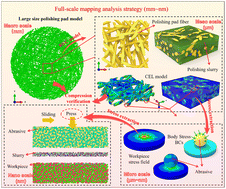Chemical mechanical polishing (CMP) is widely used to achieve an atomic surface globally, yet its cross-scale polishing mechanisms are elusive. Moreover, traditional CMP normally employs toxic and corrosive slurries, resulting in potential pollution to the environment. To overcome these challenges, a novel cross-scale model from the millimeter to nanometer scale is proposed, which was confirmed by a newly developed green CMP process. The developed CMP slurry consisted of hydrogen peroxide, sodium carbonate, sodium hydroxycellulose, and silica. Prior to CMP, fused silica was polished by a ceria slurry. After CMP, the surface roughness (Sa) was 0.126 nm, the material-removal rate was 88.3 nm min−1, and the thickness of the damaged layer was 8.8 nm. The proposed model was built by fibers, through integrating Eulerian and Lagrangian models and reactive force field-molecular dynamics. The results predicted by the model were in good agreement with those of CMP experimentally. A model for large-sized fibers revealed that a direct contact area of 11.12% was obtained for a non-woven polishing pad during the CMP experiments. Another model constructed via combining Eulerian and Lagrangian functions showed that the stress at the intersections of the fibers varied mainly from 0.1 to 0.01 MPa and was higher than the stress at other parts. An increase in viscosity led to a decrease in the areas with low stress, demonstrating that viscosity enhanced the stress and facilitated the removal of material. At the microscale and nanoscale, the stress of the abrasive surface exposed to the workpiece changed from 2.21 to 6.43 GPa. Stress at the interface contributed to the formation of bridging bonds, further promoting the removal of material. With increasing the compressive stress, the material-removal form was transformed from a single atom to molecular chains. The proposed model and developed green CMP offer new insights to understand the cross-scale polishing mechanism, as well as for designing and manufacturing novel polishing slurries, pads, and setups.
